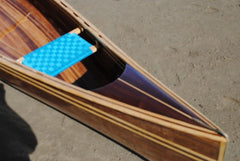Do Canoe Keels Really Work?

Way back in 2015, we made a short post called "To Keel or Not to Keel?" It very briefly covered the reasons you might be inclined to add a keel, with a few instructions on how to retrofit a finished canoe.
Turns out the old post is still attracting visitors as of summer 2021. Since it's obviously a subject builders are interested in, we wondered if we could expand on the original offering. So we asked Steve Killing, the designer of Bear Mountain Boats plans, for his thoughts.
Spoiler alert: Steve isn't a fan of keels. Take his highly knowledgeable opinion into consideration before adding a keel to your canoe, but if you still feel it's a good choice, you can read the original post for more on installation.
Steve Killing writes:
The two questions to be addressed when discussing keels on a canoe are:
- Does it help protect the boat?
- Does it help the boat to track straighter?
Protection: If you happen to run over a slightly-submerged rock exactly on centerline of the canoe then yes a keel will take the scraping and impact and save the hull itself. But if the rock is off-centre the keel will miss the target. So it will help in a very specialized situation. And I have a bit of the same problem with installing a keel to “protect” my boat as I do with bow skid-plates on fiberglass boats.
The installed keel on a wooden boat or the skid-plate on a fiberglass boat adds drag to the boat all the time to protect the hull some of the time. It doesn’t seem like a sensible trade-off.
If you do sustain damage to the boat you will either be repairing your keel or repairing your hull. I think repairing the hull may be the easier of the two.
I prefer canoes without keels.
Tracking: Adding a keel to a canoe has very little effect on straight-line tracking. The manoeuverability of a canoe is mainly set by the length and rocker of the hull. Adding a full length shallow keel to the bottom of the hull will not significantly change the tracking ability of the boat. If you were to add a deep keel aft and no keel forward you would notice the difference, but you would be better off to build or purchase a canoe that had the characteristics you are looking for already designed in to the basic shape without a keel.
Keels work well on sailboats, so let’s leave them there.

